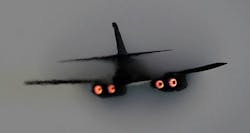Air Force chooses Raytheon to develop Global ASNT SATCOM linking nuclear forces, national commanders
Officials of the Air Force Lifecycle Management Center at Hanscom Air Force Base, Mass., have awarded a $134.4 million contract to Raytheon to design and build the Global Aircrew Strategic Network Terminal (ASNT).
The Global ASNT system will use Extremely High Frequency (EHF) and Advanced EHF waveforms to provide protected communications to nuclear bomber, missile, and support aircraft crews in difficult environments.
The terminal also will provide wing command posts and mobile support teams with survivable communications to send and receive special alerts involving nuclear forces called Emergency Action Messages.
The Global ASNT terminals that Raytheon is designing will replace existing mission-deficient unsustainable systems at bomber, tanker, and reconnaissance wing command posts and mobile support teams, Air Force officials say.
The Global ASNT terminals will provide AEHF, very-low-frequency (VLF), low-frequency (LF) and UHF aircrew alerting communications. Air Force program managers are directing Raytheon to design the Global ASNT system with an eye to future growth and systems upgrades.
The new strategic communications system will enhance the existing system by delivering increased capacity and capability, Raytheon officials say.
Raytheon is in production on three different AEHF terminals for the U.S. Army, Navy, and Air Force. All three have tested with the on-orbit AEHF satellite and have demonstrated interoperable communications.
The Global ASNT SATCOM system will provide new satellite terminals for the global command-and-control system that provides for management of nuclear forces by the president.
Raytheon will design the new terminals to receive signals from the five satellites in the MILSTAR constellation launched between 1994 and 2003 and the newer AEHF satellite system. Two AEHF satellites are in orbit today, and the Pentagon plans to launch a total of five.
New avionics computer part of B-2 bomber EHF Satcom upgrade
The new nuclear command-and-control terminals will be installed at 50 fixed sites including fixed nuclear command-and-control facilities (wing command posts, nuclear task forces, and munitions support squadrons) and forward deployed nuclear command-and-control mobile support teams. The Air Force plans to buy 48 transportable terminals.
On this contract Raytheon will do the work in Marlborough, Mass., and should finish system design and development by December 2016. Production, installation, and sustainment will extend through the end of 2020.
For more information contact Raytheon Space and Airborne Systems online at www.raytheon.com, or the Air Force Lifecycle Management Center at Hanscom Air Force Base at www.wpafb.af.mil/aflcmc.
